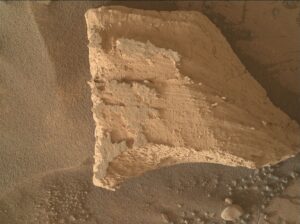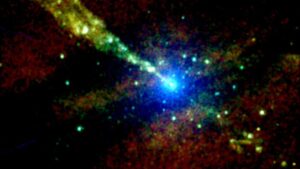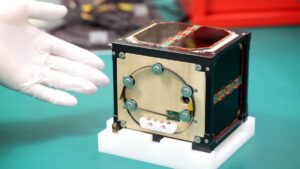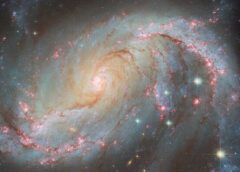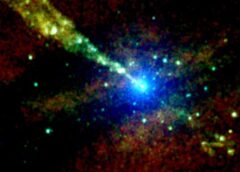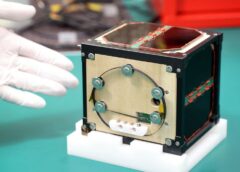The radio antennas of the NASA’s Canberra Deep Space Communications Complex are located near the Australian capital. It’s one of three Deep Space Network complexes around the world that keep the agency in contact with over 40 space missions. The DSN marks its 60th anniversary in December 2023. NASA/JPL-Caltech A single radio antenna dish stands alone at the Deep Space Network’s Canberra complex in this photo from 1969, six years after the DSN was founded. Canberra now consists of three 34-meter (112-foot) antennas and one 70-meter (230-foot) antenna. NASA/JPL-Caltech The…
Read MoreOn Cupid! On, Donner and BARREL!
NASA In this image from Dec. 8, 2017, four reindeer walk past the Balloon Array for Radiation-belt Relativistic Electron Losses, or BARREL, payload on the launch pad at Esrange Space Center near Kiruna, Sweden. BARREL primarily measured X-rays in Earth’s atmosphere near the North and South Poles. These X-rays are caused by electrons that rain down, or precipitate, into the atmosphere from the giant swaths of radiation that surround Earth, called the Van Allen Belts. Understanding this radiation and its interaction with Earth’s atmosphere helps us to learn about planetary…
Read MoreNASA Issues New Space Security Best Practices Guide
NASA Logo. NASA As space missions and technologies grow increasingly interconnected, NASA has released the first iteration of its Space Security Best Practices Guide to bolster mission cybersecurity efforts for both public sector and private sector space activities. The guide represents a significant milestone in NASA’s commitment to ensuring the longevity and resilience of its space missions and will serve as a resource for enhancing their security and reliability. Additionally, the Space Security Best Practices Guide was designed to benefit users beyond NASA – international partners, industry, and others working…
Read MoreA Look Through Time with NASA’s Lead Photographer for the James Webb Space Telescope
2 Min Read A Look Through Time with NASA’s Lead Photographer for the James Webb Space Telescope This self portrait of Chris Gunn, standing in front of NASA’s James Webb Space Telescope from inside the Goddard Space Flight Center cleanroom, was captured November 10, 2016. Credits: NASA/Chris Gunn Nearly two years ago in the early morning hours of Dec. 25, NASA’s James Webb Space Telescope successfully took flight from the jungle-encircled ELA-3 launch complex at Europe’s Spaceport near Kourou, French Guiana. Following a successful deployment in space, and the precise…
Read MoreMeet the Infrared Telescopes That Paved the Way for NASA’s Webb
Scientists have been studying the universe with infrared space telescopes for 40 years, including these NASA missions, from left: the Infrared Astronomical Satellite (IRAS), launched in 1983; the Spitzer Space Telescope, launched in 2003; and the James Webb Space Telescope, launched in 2021. NASA/JPL-Caltech The Webb telescope has opened a new window onto the universe, but it builds on missions going back 40 years, including Spitzer and the Infrared Astronomical Satellite. On Dec. 25, NASA will celebrate the two-year launch anniversary of the James Webb Space Telescope – the largest…
Read MoreNASA Asteroid Sampling Mission Renamed OSIRIS-APEX for New Journey
5 min read Preparations for Next Moonwalk Simulations Underway (and Underwater) At the end of a long-haul road trip, it might be time to kick up your feet and rest awhile – especially if it was a seven-year, 4 billion-mile journey to bring Earth a sample of asteroid Bennu. But OSIRIS-REx (Origins, Spectral Interpretation, Resource Identification and Security – Regolith Explorer), the NASA mission that accomplished this feat in September, is already well on its way (with a new name) to explore a new destination. When OSIRIS-REx left Bennu in…
Read MoreAn Apollo 8 Christmas Dinner Surprise: Turkey and Gravy Make Space History
6 min read Preparations for Next Moonwalk Simulations Underway (and Underwater) On Christmas Day in 1968, the three-man Apollo 8 crew of Frank Borman, Jim Lovell, and Bill Anders found a surprise in their food locker: a specially packed Christmas dinner wrapped in foil and decorated with red and green ribbons. Something as simple as a “home-cooked meal,” or as close as NASA could get for a spaceflight at the time, greatly improved the crew’s morale and appetite. More importantly, the meal marked a turning point in space food history.…
Read MoreHubble Sights a Galaxy with ‘Forbidden’ Light
2 min read Hubble Sights a Galaxy with ‘Forbidden’ Light This NASA Hubble Space Telescope image features a bright spiral galaxy known as MCG-01-24-014, which is located about 275 million light-years from Earth. ESA/Hubble & NASA, C. Kilpatrick This whirling image features a bright spiral galaxy known as MCG-01-24-014, which is located about 275 million light-years from Earth. In addition to being a well-defined spiral galaxy, MCG-01-24-014 has an extremely energetic core known as an active galactic nucleus (AGN) and is categorized as a Type-2 Seyfert galaxy. Seyfert galaxies, along with quasars, host one of…
Read MoreWatch live as private Cygnus cargo craft leaves the ISS on Dec. 22
A robotic cargo ship will depart from the space station on Friday (Dec. 22), and you can watch the action for free. Northrop Grumman’s uncrewed Cygnus NG-19 spacecraft should undock from the International Space Station (ISS) at 8:05 a.m. EST (1305 GMT) on Friday. You can watch coverage here at Space.com, via NASA Television, starting at 7:45 a.m. EST (1245 GMT). Cygnus has spent 4.5 months at the orbiting complex, following an Aug. 4 arrival that brought up 8,200 pounds (3,800 kilograms) of hardware, supplies, science, commercial products and other…
Read MoreNASA Flies Drones Autonomously for Air Taxi Research
3 min read Preparations for Next Moonwalk Simulations Underway (and Underwater) An Alta-8 small Unmanned Aircraft System testbed vehicle flies above NASA’s Langley Research Center in Hampton, Virginia. Flying beyond visual line of sight from observers on the ground required special approval from the Federal Aviation Administration and NASA. NASA / Bowman Researchers at NASA’s Langley Research Center in Hampton, Virginia recently flew multiple drones beyond visual line of sight with no visual observer. The drones successfully flew around obstacles and each other during takeoff, along a planned route, and…
Read More
